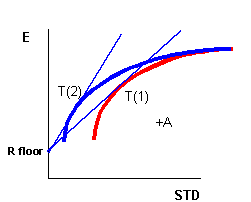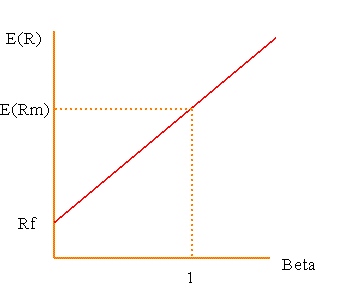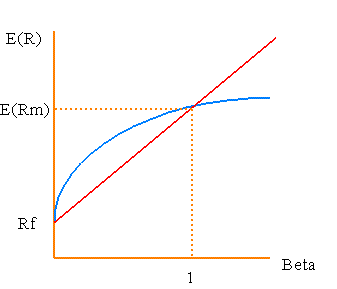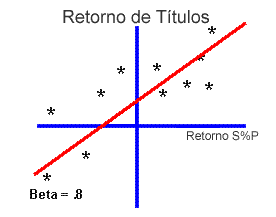
© William N. Goetzmann
YALE School of Management
Traduzido por L.A. Bertolo
FAFICA - Departamento de Ciências Contábeis


II. Um Modelo dos Retornos Esperados
In the preceding example, notice that we used the expression expected
returns. That is, we found an equation that related the expected future return
of asset A (in excess of the riskless rate) to the expected future return of
the market (in excess of the riskless rate). This expected return is the return
that investors will demand when asset prices are in the equilibrium described
by the CAPM. For any asset i, the CAPM argues that the appropriate rate at which
to discount the cashflows of the firm is that same rate that investors demand
to include the security in their portfolio:



É importante a tensão que a dimensão vertical na figura
da linha de mercado de títulos é o retorno esperado.
As coisas raramente se mostram do modo que você espera. Entretanto, a
equação CAPM também nos diz sobre a taxa realizada
de retorno. Desde que a realização é apenas a expectativa
mais o erro randômico, podemos escrever:
V. Um Exemplo
O apelo do CAPM é claro -- ele radicalmente simplifica um problema inerentemente
complexo e preocupante. A questão da taxa de desconto apropriada se torna
virtualmente um cálculo de parte de trás-do-envelope! Na realidade,
se você conhece o beta do título, estimando a taxa de desconto
num estalo: multiplique o beta vezes o prêmio de risco esperado da carteira
de mercado em cima da taxa sem risco.
For example, suppose you are a banker considering a private equity investment
in a company with a new drug process. The process is inherently risky, i.e.
the standard deviation of the project is 75% per year. O beta do projeto é
0,5. O Rf = 5% e o E[Rm] = 13,5%. Qual é a taxa de retorno requerida
sobre o projeto?
A teoria diz-nos que a resposta não depende da volatilidade associada
com os retornos. Em vez disso usa o beta do projeto.
VI. Como Você Estima o ß?
O ß pode ser tudo o que precisamos, mas não é imediatamente
claro como seria estimado. What we really need is a quantitative estimate of
how the future return changes in response to future changes in the world market
portfolio. Good Luck! It is tough to even guess the empirical composition of
the market portfolio, let alone estimate a beta. In practice (although it is
not theoretically justified) analysts typically use the S&P 500 equity risk
premium in this calculation. To estimate beta, regress the security returns
for the past several periods (usually 60 months) on the market returns. The
slope in this regression is an estimate of ß.

VII. Avaliação do CAPM
The CAPM is a classical model in finance. It is an equilibrium argument that, if true, answers most important investment questions. It tells us where to invest, how to invest and what discount rate to use for project cash flows. Not only that, it is a disarmingly simple model. The expected return of a security depends upon a simple statistic: ß. The relationship between risk and return is linear. Calculation of portfolio risk is trivial. At the same time, the CAPM is revolutionary. It tells us that the variance of a project is NOT a factor in determining the appropriate, risk-adjusted discount rate. It turns financial research from roll-up-your-sleeves fundamental analysis into a statistics problem. In short, the CAPM turned Wall Street on its head.
VIII. Conclusão. O CAPM é Verdadeiro?
Here comes the bad news. Despite twenty years of attempts to verify or refute the Capital Asset Pricing Model, there is no consensus on its legitimacy. There are a few hints that the model is incorrect. For starters, we all hold different portfolios. Therefore, it cannot be exactly true. Researchers have focused upon the more interesting issue of whether rates of return depend upon ß and whether the elegant, linear form of the model holds for stocks. What they have found is that real markets typically deviate broadly from the exact model. While there are long periods in U.S. Capital market history when realized returns are positively related to betas, there are also long periods when they are not. Among the most forceful arguments against the CAPM advanced in recent times is a study by Eugene Fama and Kenneth French. These authors found that beta did a relatively poor job at explaining differences in the actual returns of portfolios of U.S. stocks. Instead, Fama and French noted that there were other variables besides beta with respect to the market that explained returns. Some of these were "fundamental" ratios long used by financial analysts in the pre-CAPM era such as Book to Market Ratio and Earnings Price Ratio. Another was simply the relative size of the company. The evidence against the CAPM continues to grow and despite its elegance, most researchers have turned to more more complex, but more powerful models.
 © William N. Goetzmann
© William N. Goetzmann